Jasmine Cultivation Guide:
Introduction to Jasmine Cultivation:- Jasmine is an excellent fragrant flowers being cultivated since centuries. Jasmine flower has many uses and some of them include; making garlands for religious purpose, bouquet, women hair decoration. When it comes to commercial use, some of the Jasmine varieties are exclusively grown for Jasmine oil (concentrate) to use in cosmetic and perfume industries. Though there are many Jasmine varieties found across the world, more than 75 to 80 jasmine species grown in Indian region itself. The commercial cultivation of Jasmine types include; J.grandiflorum (Jathimalli/Pitchi), Jasminum sambac (Gundumalli/Madurai Malli), & J.auriculatum (Mullai). The first jasmine type is mainly grown for its oil (concentrate extraction) and other two types are cultivate for fresh flowers. Now a days, herbal companies are preparing tea from jasmine flowers. This plant has around 200 species and is native to tropical regions of Southeast Asia, Africa, and Australia. Out of these, 80 species are found in India. Commercial growers of jasmine may even tie up with these herbal companies. Jasmine flowers are exported from India to neighbouring countries like Bangladesh, Sri Lanka, Middle East, Singapore and Malaysia. The following content details about Jasmine Cultivation.
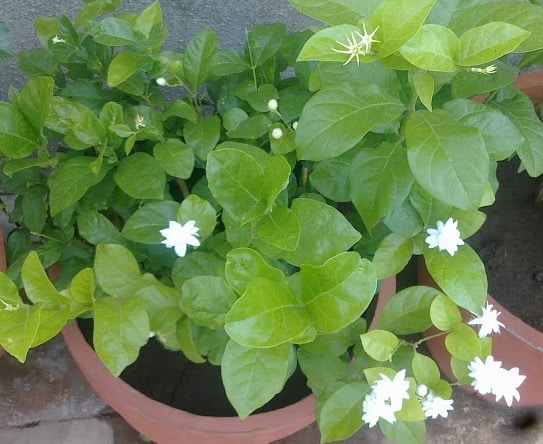
Generally, Jasmine crop requires lots of manpower for harvesting and other tasks. Hence, most of the small farmers are considering this crop under 1 acre land holdings. The jasmine flower has great commercial value, and one can get decent profits due to its market potentiality. Jasmine plant is a bushy shrub or a climbing vine and considered as non-poisonous. There are two ways one can cultivate this crop on commercial scale. The first one is the open field and other one is under greenhouse/poly house conditions. Yield and quality of flowers are great especially when grown under greenhouse/ poly house conditions. In countries like India, farmers can get up to 70% of subsidy on setting up playhouses in most of the states.
Apart from commercial growing of jasmine, they can be grown in home gardens, indoors, backyards, pots, containers, balconies, and terrace and even in bedrooms.
Scientific Name or Botanical Name of Jasmine Plant:- “Jasminum spp”.
Family Name of Jasmine Plant:- “Oleaceae” (olive family).
Genus of Jasmine Plant:- Jasminum L.
Major Types of Jasmine Flowers:- The following are major categories of jasmine plants.
- Jasminum grandiflorum : (Jathimalli (or) Pitchi (or) Spanish jasmine)
- Jasminum auriculatum : (Mullai)
- Jasminum pubescens : (Kakada)
- Jasminum sambac : (Malligai/Gundumalli /Arabian jasmine /Tuscan jasmine).
Jasmine Names in World Languages:- Jasminum (Dutch), Jasminum (German), Jaśmin (Polish), 茉莉花 (Chinese), Sampaguita (Filipino), Jasminum (Italian), ياسمين (Arabic), Jasminum (Spanish), Jaeseumin (Korean), Seasmain (Irish), Jasmiin (Estonian), Γιασεμί (Greek), Jasmim ( Portuguese), चमेली (Nepali), Jasmin ( Norwegian), มะลิ (Thai), Chi Nhài (Vietnamese), Malati (Sundanese), Hasmig (Armenian), Jasmiinit (Finnish), Jasumin (Japanese), කොඳ / Saman Pichcha ( Sinhalese), Jasmín (Czech), Jasmin (French), јасмин (Macedonian), Jasminsläktet (Swedish), Жасмин (Russian), Yasemin (Turkish), Jasmin (Danish), ჟასმინი (Georgian), Jázmin (Hungarian), Pokok Bunga Melur (Malay), Yasmin (Persian), and Kundaha /Malati (Sanskrit).
Jasmine Names in Indian Languages:- Mogra / Juhi / Chameli / Champa Bela (Hindi), Mallepoovu (Telugu), Bel Phul (Bengali), மல்லிகை (Tamil), یاسمین (Urdu), മുല്ല (Malayalam), Chameli / ਚਮੇਲੀ (Punjabi), એક ફૂલવેલ (Gujarati), Malhi (Oriya), Mallige / ಮಲ್ಲಿಗೆ (Kannada), and Chameli (Marathi).
Jasmine Production States in India:- Tamil Nadu state is the top producer of jasmine flowers in India. However, Jasmines are grown through the country.
- Tamil Nadu
- Karnataka
- Andhra Pradesh
- Assam
- Telangana
- Maharashtra
- Bihar
- Pondicherry
- Chhattisgarh
- Goa
Health Benefits and Uses of Jasmine:- The following are some of the health benefits and uses of Jasmines.
- Mainly two parts jasmine plant is used; Jasmine flowers and its oil
- The jasmine lotion helps to reduce the skin problems
- Jasmine tea helps in relieving stress and anxiety
- Jasmine oil is an anti-depressant, aphrodisiac
- Jasmine oil is also used as therapeutic massage oil
- Jasmine tea has wonderful health benefits and known to be beneficial in treating fevers, urinary inflammation
- Jasmine oils are used in many cosmetic and perfumery industries
- Jasmine oils are used in herbal remedies and in aromatherapy.
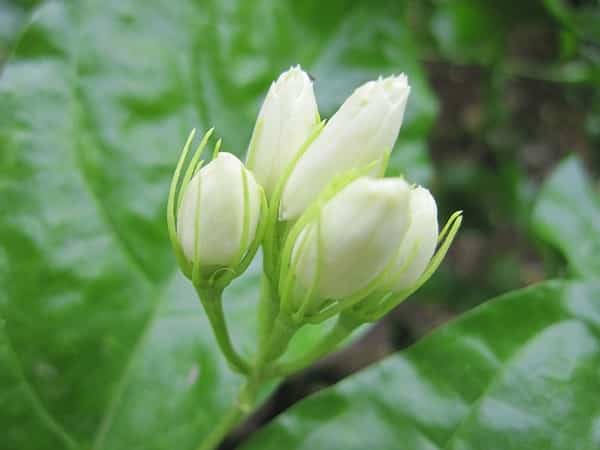
Varieties (Cultivars) of Jasmine:- There are many varieties grown in the world. However, Jasminum Auriculatum, Jasminum Multiflorum, Jasminum Grandiflorum and Jasminum sambac are important species under in which most of these varieties are grown. You should contact your local department of horticulture for specific high yielding and good fragrance variety suitable for your region. Some of the popular jasmine varieties cultivated in India are; Jasminum sambac (Gundumalli), Co-1, Co-2 (J. Auriculatum), Co-1, Co-2 (J. Grandiflorum), Parimullai, Ramban and Madanban, Double Mogra.
Jasmine Price is Influenced by these Factors in the Market:
- Freshness, color, aroma/fragrance and size of the Jasmine flower buds
- Average annual production of jasmine crop in the region
- Time of arrival of the crop in the market
- Climatic conditions
Factors to be Considered for Commercial Cultivation of Jasmine Crop:
- You must draft a jasmine farming business plan based on the cultivation area.
- You must estimate labour (man power) cost, seed cost, manure / fertilizer cost, irrigation cost, and any other costs. These details needs to be included in financials of business plan prepared in first step.
- Before starting a crop, make sure to have proper marketing channel to sell the jasmine flowers.
- In case of exporting jasmine flowers, you need to contact horticulture department and concerned authorities for actual export procedure.
- If you don’t have ground water, never plan for this crop. Ensure you enough water sources especially during dry/hot summer.
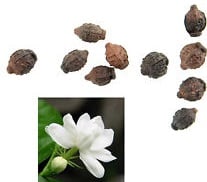
Agro-Climatic Conditions Requirement for Jasmine Cultivation:- Jasmine crop prefers mild and tropical climatic conditions. This crop requires a well-distributed annual rain fall of 900 to 1000 mm. Now a days, it is picking up the poly house culture of growing jasmines due quality and high yields. Jasmine crop can come up very well in a warm summer, moderate rainfall and mild winter conditions. These plants can be grown up 1200 meter (above m.s.l). However, most of the commercial cultivation of jasmine flowers practiced in open fields.
Soil Requirement for Jasmine Cultivation:- Well, Jasmine crop can be grown on a wide varieties of soil types. However, it requires Well-drained sandy loam soils rich in organic matter. The ideal soil pH for jasmine cultivation ranges from 6.5 to 7.5.
Propagation in Jasmine Cultivation:- Jasmine crop can be propagated through the following methods.
- Cuttings
- Layering
- Suckers
- Grafting
- Budding
- Tissue culture
Land Preparation, Planting and Spacing in Jasmine Cultivation:- Land should be made weed free by giving couple of ploughings with local tractor. Bring the soil to fine tilth stage and dig out the pits with a size of 30 cm x 30 cm x 30 cm. Make sure these pits are exposed to sunlight for 2 to 3 weeks to prevent any soil borne disease or termites. Each pit should filled with 10 kg of well-decomposed farm yard manure (FMY) before filling the pits with top soil. Generally, planting season of jasmine is during onset of monsoons. The plant to plant distance should be 1.5 meter x 1.5 meter. Well-rooted, healthy and strong seedlings of jasmine obtained from cuttings / layering should be selected for planting in the prepared pits. Once planted, the jasmine plants remain in the field for 10 to 15 years. Planting can be done at any time during the year under greenhouse /poly house conditions.
Water Management in Jasmine Cultivation:- Timely watering the jasmine plants is very important for achieving good growth and high flower yields. Adequate moisture at the plant base is essential for proper growth and production of flowers. You can adopt drip irrigation method or flood irrigation. First irrigation should be carried out immediately after planting in the field. Subsequent irrigation should be given at an interval of 4 to 5 days depending upon the climate and soil type (moisture holding capacity). Do not over water and make sure the water is well-drained from the plant base in rainy season.
Manures and Fertilizers in Jasmine Cultivation:- The application of manures and fertilizers on time has great impact on Jasmine crop. Jasmine crop responds very well to application of manures and fertilizers. It is advised to apply 10 ‘kg’ of well-decomposed farm yard manure (FYM) during the pits preparation and 60 grams of ‘N’ (Nitrogen), 120 grams of Phosphorus and 120 grams of Potassium to each plant. These nutrients should be applied in 2 split doses, one after annual pruning and another during June – July.
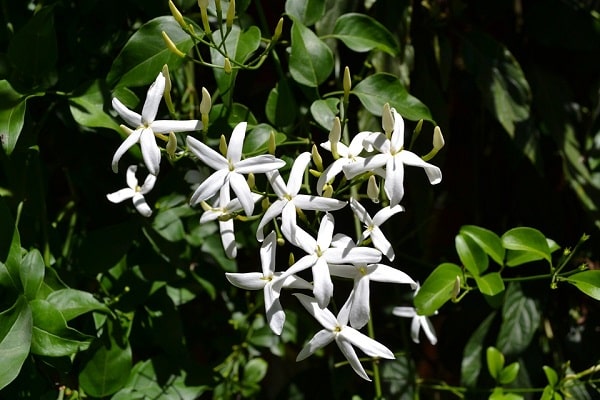
Intercultural Operations in Jasmine Cultivation:-
- Weed Control in Jasmine Cultivation: As we know to obtain healthy crop, we should make sure weed free field as these weeds competes with the main crop for nutrients and water. Weeding should be done frequently in jasmine orchard. After pruning of the plants, the soil 20 to 30 cm from the main stem around the bushes should be stirred to a depth of 15 cm. Repeat this task for every 2 months. In case of heavy weeds, appropriate chemical weed controllers can be applied. Chemical weed control is cheaper than manual weed control. You can also go for mulching which is very beneficial for controlling weeds, protecting from soil erosion, and preventing water moisture from the plant base.
- Pruning in Jasmine Cultivation: Generally, training is carried out to give the desired shape of plant (good framework) whereas pruning is carried out to encourage the new shoots of the plant. Stop the irrigation before pruning and prune the jasmine plants to half their original length /size. Make sure to do the pruning at least 40 cm from the ground level. All the plant leaves should be stripped off after pruning. In India, it is advised to prune the jasmine plants during the last week of November to get more yield and quality jasmine flowers.
- Inter-cropping in Jasmine Cultivation: During initial years of planting, you can find some good space between the plants. You can utilize this space for growing vegetable crops which can result in additional income.
Pests and Diseases in Jasmine Cultivation:- Controlling pests and diseases is essential in any orchard.
The following pests are commonly found in jasmine cultivation.
- Red spider mite: To control this pest, pray sulfur (50% WP) @ 2 grams / litre of water.
- Bud worm and Blossom midge: Spry monocrotophos 36 WSC @ 2 ml /later of water to control bud worm and blossom midge.
The major diseases found in Jasmine cultivation are:
- Nematode: To control this disease, apply 10 grams of Temic granules / plant nearer to root zone.
- Root rot: To control root rot disease, drench the soil around plant with Copper oxychloride @ 2.5 grams / litre water.
- Note:Your local horticulture department is good source to find the solutions for controlling pests and diseases in Jasmine cultivation.
Harvesting Flowers in Jasmine Cultivation:- Generally, Jasmine plants start flowering after 6 months of planting. Fully developed unopened flower buds should be handpicked in the early morning or late evening. As shelf life these flowers many not that long, they should be packed and sent to market after picking. Jasmin plants can produce flowers for 12 to 15 years of period.
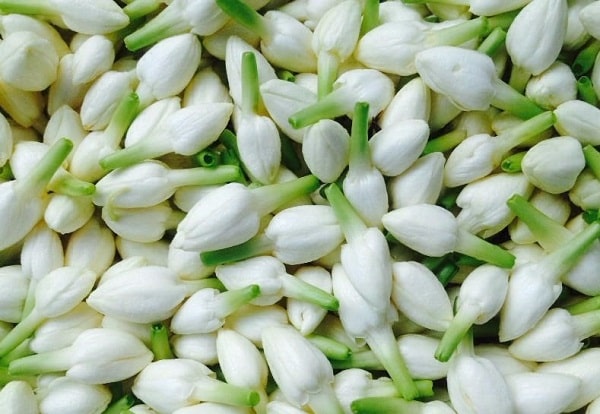
Make sure the jasmine flowers are not damaged during harvest and transit as this can affect the shelf life of flowers and jasmine oil recovery.
Yield in Jasmine Cultivation:- Yield of Jasmine crop depends on the variety, soil type, climate , plant age and other orchard management practices. The following yield can be expected depending on the species.
Species Flowers yield (kg/ha) Concrete (oil) recovery (%)
auriculatum 4700 to 9150 0.30 to 0.35
sambac 740 to 8129 0.15 to 0.20
grandiflorum 4300 to 10100 0.25 to 0.35
Bottom Line of Jasmine Cultivation:- Try to grow these flowers in greenhouse /poly house for maximum yields and quality of flowers.

From where i can get the good jasmine plants for cultivation
You should contact certified nurseries for good quality and high yield Jasmin saplings.
Please advise which type of polyhouse is suitable for grown up the Jasmine plant farm.